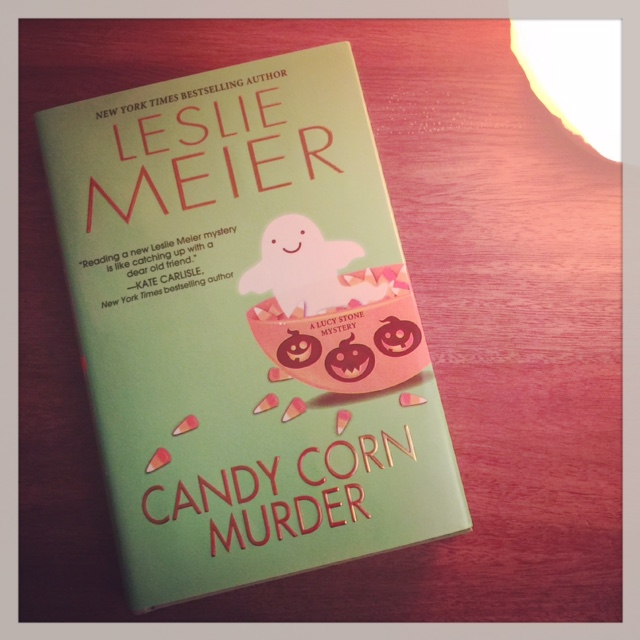
We are now firmly in the grip of my favorite time of year – the months of October through December. I love the change of seasons. I love pumpkins and gingerbread (in all their decorative, imbibe-able, and edible forms). And I love seasonal reading.
With my son well out of the picture books stage, lingering at the Halloween display in the children’s section is more an exercise in nostalgia than a shopping expedition (sniffle). When I slowed down to admire one such display earlier today, I got to thinking about the books we could put in a grown-up Halloween reads display. Here are a few I came up with, and I’d love to hear your suggestions in the comments!
Leslie Meier’s “Candy Corn Murder”
I found this one in a murder mystery display, and it’s one in a series following Lucy Stone: mom, Pennysaver reporter, and crime solver. The smiling ghost and the ghoulishly cute title first caught my attention, but I also loved that it’s set in Maine and revolves around a giant pumpkin competition, and includes loads of other autumnal, New Englandy events. Purely coincidentally, I happened to be reading the novel the same weekend that Ridgefield hosted its annual Giant Pumpkin Weight-Off.
I was pleased to discover that Lucy Stone does quite a lot of crime solving during holidays: Quite a few of the novels take place during holidays, including those taking place between Oct. 31 and Jan. 1.
Bram Stoker’s “Dracula”
This gothic horror novel has been on my reading list for at least three years. It tells the story of Dracula, a Transylvanian vampire who moves to London is search of fresh blood and new converts, and the men and women who fight him. I’m hoping this will be the year I finally cross this off my to-be-read list.
You can read the novel by clicking here.
Edgar Allan Poe’s “The Raven”
The rhyme and meter of this poem are epic. I could recount the poem's symbolism and complexity and all the stuff scholars like to talk about, but really, it’s simply majestically moody and mystic. And even though the subject is rather dark, the musicality of the structure makes feeling depressed after reading it kind of hard. First published in 1845, it has provided inspiration for plenty of re-dos. But nothing beats the original, right?
You can read it by clicking here.
Set in a New York Dutch settlement circa 1790 and first published in 1860, “The Legend of Sleepy Hollow” is a charming romp (for a ghost story) through post-Revolutionary New York. The holiday-appropriate story follows the exploits of the somewhat stuffy and wily schoolteacher Ichabod Crane in his quest to woo the lovely (and wealthy) Katrina Van Tassel. Irving’s ghoulish (but not fully terrifying) stories and wryly humorous prose combine to create a Halloween story that’s more likely to make you smile than to give you nightmares.
You can read it by clicking here.
Edgar Allan Poe’s “The Tell-Tale Heart”
Actually, many of Poe’s short stories work for Halloween, but for some reason, this one always gets to me. The ghastly tale of a murderer haunted by his crime is frantically paced and quite creepy.
You can read it by clicking here.
Mary Shelley's "Frankenstein"
Mary Shelley's eponymous Frankenstein is Victor, a young man so enamored of the natural sciences and so keen on charting new territory that he collects leftover human parts and figures out how to create a living being with them. But he’s so horrified by the being he creates that Frankenstein rejects and flees from him, leaving the monster to fend for himself. Hideously disfigured and continuously spurned by society, he turns nasty, and he and Frankenstein end up pursuing each other across Europe.
You can read it by clicking here.
Edith Wharton's "Tales of Men and Ghosts"
Wharton’s supernatural/psychological thriller stories, 10 of which are collected in "Tales of Men and Ghosts," combine wry humor with emotional tension. Also, they’re creepy as … well, you know. For example, in the first one, "The Bolted Door," Hubert Granice is so disgusted by his inability to get published that he wants to commit suicide. But each time he attempts it, his hands tremble, and he can't go through with it. So he devises a plan to get himself convicted of murder and sentenced to the death penalty, only nothing goes as planned. The story is simultaneously hilarious and chilling.